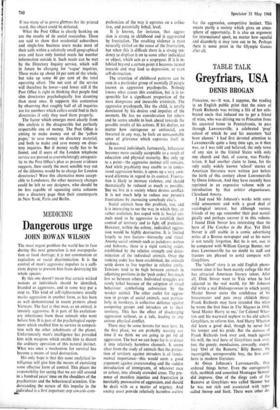Dangerous urge
MEDICINE JOHN ROWAN WILSON
The most urgent problem the world has to face during this next generation is not overpopula- tion or food shortage; it is not communism or capitalism or racial discrimination. It is the control of man's aggressive impulses to a suffi- cient degree to prevent him from destroying his whole species.
By this one doesn't mean that certain wicked nations or individuals should be identified, branded as aggressors, and in some way put a stop to. This kind of self-righteousness usually masks aggression in another form, as has been so well demonstrated in recent protests about Vietnam. The fact is that man, as an animal, is innately aggressive. It is part of his evolution- ary inheritance from those animals who went before him. It is part of the psychological equip- ment which enabled him to survive in competi- tion with the other inhabitants of the planet. Unfortunately man's intelligence has provided him with weapons which enable him to distort the ordinary operation of this natural instinct. What was once a mechanism for survival has become a means of total destruction.
His only hope is that this same analytical in- telligence will give him the means of exercising some effective form of control. This places the responsibility for seeing that we are still around in a hundred years' time on the shoulders of the psychiatrists and the behavioural scientists. Un- derstanding the nature of this impulse in the akdividual is a first important step towards corn-
prehension of the way it operates on a collec- tive, and potentially lethal, leveL It is known, for instance, that aggres- sion is strong in childhood and is aggravated by frustration. The resulting violence is most naturally visited on the cause of the frustration, but when this is difficult there is a strong ten- dency to displace it on to some other individual or object, which acts as a scapegoat. If it is in- hibited beyond a certain point it becomes turned inwards and may lead to depression, or even self-destruction.
The retention of childhood patterns can be seen in a particular group of mentally ill people known as aggressive psychopaths. Nobody knows what causes this condition, but it is re- sponsible for a significant proportion of the most dangerous and incurable criminals. The aggressive psychopath, like the child, is totally dominated by his desires and impulses of the moment. He has no consideration for others and he seems unable to look ahead towards the possible results of his actions. If his desires, no matter how outrageous or antisocial, are thwarted in any way, he feels an unreasonable sense of grievance which expresses itself in violence.
In normal individuals, fortunately, behaviour becomes more socially acceptable as a result of education and physical maturity. But only up to a point—the aggressive instinct still remains.
And while psychiatry may enable us to under- stand aggression better, it opens up a very awk- ward dilemma in regard to its control. Frustra- tion is likely to increase violence, and should theoretically be reduced as much as possible. But we live in a society where desires conflict. It is not much help to reduce one person's frustrations by increasing somebody else's.
Social animals have this problem, too, and it is interesting to see the way in which they, or rather evolution, has coped with it. Social ani- mals need to be aggressive to establish their control of territory and to fight off predators.
However, within the colony, individual aggres- sion would be highly destructive. It is limited largely to two factors—hierarchy and ritual.
Among social animals such as jackdaws, wolves and baboons, there is a rigid ranking order, established by the relative strength and deter- mination of the individual animals. Once the ranking order has been established, the animals settle down to live together in relative amity.
Tensions tend to be high between animals in adjoining positions in the 'peck order,' but much less so between others. Individual struggles are rarely lethal because of the adoption of ritual behaviour symbolising submission by the weaker animal. The other outlet for aggres-
sion in groups of social animals, seen particu-
larly in monkeys, is collective defiance against competing groups and intruders on to their territory. This has the effect of discharging aggression without, as a rule, leading to any serious physical conflict.
There may be some lessons for man here. In the first place, we are probably wasting our time if we think we are going to get rid of aggression. The best we can hope for is to direct it into relatively harmless channels. It seems clear from the study of animals that the protec- tion of territory against intruders is of funda- mental importance—this would seem a good argument against overcrowding and the sudden introduction of immigrants, of whatever race or colour, into already crowded areas. The pre-
sence of manifest injustice and frustration is inevitably provocative of aggression, and should be dealt with as a matter of urgency. And society must provide relatively harmless outlets
for the aggressive, competitive instinct. This means partly a society which gives an atmo- sphere of opportunity. It is also an argument for international sport, no matter how squalid and disorderly it may turn out to be. Perhaps there is some point in the Olympic Games after all.






































 Previous page
Previous page